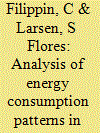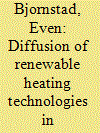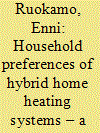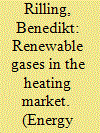|
|
|
Sort Order |
|
|
|
Items / Page
|
|
|
|
|
|
|
| Srl | Item |
| 1 |
ID:
090075


|
|
|
|
|
| Publication |
2009.
|
| Summary/Abstract |
This paper analyzes the energy consumption during the period 2001-2006 of 192 flats distributed in three-storey buildings, in order to understand how current policies related to energy use could be improved for increased residential energy efficiency in Argentina. The buildings (1, 2 and 3 bedrooms) are located in La Pampa, central Argentina, in a moderate cold climate. The dimensional and energy-consumption variables are studied (area, envelope's area, FAEP=envelope's area/floor area; envelope's thermal resistance R, volumetric heat loss G and auxiliary heating Qaux). The natural gas consumption is analyzed at annual and seasonal levels. Consumption variability among buildings, storeys and flats is calculated. The quantitative analysis is coupled to a qualitative description through direct observation of the buildings. The results show: (a) a high incidence of natural gas consumption in the total annual energy consumption (natural gas+electricity), (b) seasonality of natural gas consumption, with a maximum value in the cold period July-August (variability=80%), (c) little variability among buildings of the annual natural gas consumption (4.17%), (d) the lowest average energy consumption at the first floor, (e) high variability among flats on each storey, (f) winter consumption of a multi-family dwelling lower than a single-family dwelling of similar area and (g) little seasonal variability of the electricity consumption.
|
|
|
|
|
|
|
|
|
|
|
|
|
|
|
|
| 2 |
ID:
115116


|
|
|
|
|
| Publication |
2012.
|
| Summary/Abstract |
A sample of 896 Norwegian households participating in a subsidy programme was surveyed in order to evaluate the success of the programme. The programme subsidised investments in new heating technologies, including heat pumps and pellet stoves. The success of the programme was measured by the degree of overall satisfaction with the investment by the sampled households. Theories on diffusion of innovations and planned behaviour motivate the empirical modelling of the investment satisfaction.
The economic return on the investment varied substantially both within and between the two heating technologies, with heat pumps outperforming pellet stoves in this respect. Still, the economic return showed no explanatory power toward the investment satisfaction of the household. Among the economic variables, only the electricity price had any influence on investment satisfaction. Technical quality, indoor climate and heat comfort, and the availability of the supplier of the heating equipment were the most important explanatory variables.
|
|
|
|
|
|
|
|
|
|
|
|
|
|
|
|
| 3 |
ID:
098565


|
|
|
|
|
| Publication |
2010.
|
| Summary/Abstract |
Considering the increasing attention on efficient use of energy, it becomes vitally important to understand the energy-related behavior of households. This article presents empirical evidence on the determinants of the space heating technology applied by a household. Three sets of variables are examined as potential influences-building, socio-economic, and regional characteristics. To highlight both the differences and similarities, the results are obtained from a sample of house owners, and from a sample including all households. The influence of socio-economic factors is similar across these groups. Income is found to exert only a minor impact on the system choice. Dwelling features are significant in determining the heating type, particularly in the sample including all households. Regional effects are important-clear differences prevail between East and West Germany.
|
|
|
|
|
|
|
|
|
|
|
|
|
|
|
|
| 4 |
ID:
097206


|
|
|
|
|
| Publication |
2010.
|
| Summary/Abstract |
In order to value the costs and benefits associated with improved space heating we analysed the Housing, Heating and Health Study, a randomised community trial involving installation of energy efficient and healthy heaters (heat pump, wood pellet burner or flued gas heater) in homes with basic insulation and poor heating, occupied by households which included a child with asthma. We compared the initial purchase and installation cost of heaters with changes in the number of visits to health professionals, time off work/school, caregiving, and pharmaceutical use for household members and changes in total household energy use and carbon emissions following the intervention. We used two scenarios to analyse the results over the predicted 12-year life-span of the heaters. The targeted approach (Scenario A - assuming high rates of household asthma throughout the period of analysis) produced enough health-related benefits to offset the cost of the heaters, and when total energy use and carbon emission savings were included in the analysis the ratio of benefits to costs was 1.09:1. The untargeted approach (Scenario B - assuming typical New Zealand asthma rates throughout the period of analysis) had a ratio of total benefits to costs of 0.31:1.
|
|
|
|
|
|
|
|
|
|
|
|
|
|
|
|
| 5 |
ID:
150738


|
|
|
|
|
| Summary/Abstract |
The residential heating sector presents considerable energy savings potential, as numerous heating solutions for reducing electricity consumption and utilizing renewable energy sources are available in the market. The aim of this paper is to examine determinants of household heating system choices and to use this information for policy planning purposes. This paper investigates residential homeowner attitudes regarding innovative hybrid home heating systems (HHHS) with choice experiment. Heating system scenarios are designed to represent the most relevant primary and supplementary heating alternatives currently available in Finland. The choice sets include six main heating alternatives (district heat, solid wood, wood pellet, electric storage heating, ground heat pump and exhaust air heat pump) that are described by five attributes (supplementary heating systems, investment costs, operating costs, comfort of use and environmental friendliness). The results imply that HHHSs generally appear to be accepted among households; however, several factors affect perceptions of these technologies. The results reveal differing household attitudes toward the main heating alternatives and show that such views are affected by socio-demographic characteristics (age, living environment, education, etc.). The results suggest that households view supplementary heating systems (especially solar-based) favorably. The other attributes studied also play a significant role in decision making.
|
|
|
|
|
|
|
|
|
|
|
|
|
|
|
|
| 6 |
ID:
114300


|
|
|
|
|
| Publication |
2012.
|
| Summary/Abstract |
Natural Gas (NG) is commonly used for satisfying population needs for heating, domestic hot water production and cooking, particularly in countries where the price of electricity is high. Typically, NG is extensively distributed on urbanized territory and can be exploited by using different technologies. As a consequence, primary energy is usually consumed directly in buildings, allowing high efficiency conversion but also producing pollutants in urban areas. In this paper a comprehensive analysis on NG use in the Italian domestic and tertiary building sector has been carried out, in order to evaluate energy and environmental impact of this fuel on different climatic and geographical contexts, also considering the temporal fluctuation of consumption. The aim of the work is to trace a reliable and up-to-date scenario of NG employment for building heating in Italy, which is one of the EU countries where this source is more widely used.
The study was carried out under the research program "Analysis and evaluation of the current status of the reduction measures of environmental impacts due to heating energy consumption in Italy", funded by the Italian Ministry of Environment.
The data presented are an essential basis for the development of building energy efficiency and consumption rationalization policies.
|
|
|
|
|
|
|
|
|
|
|
|
|
|
|
|
| 7 |
ID:
178820


|
|
|
|
|
| Summary/Abstract |
Replacing natural gas with biomethane is an option to help decarbonize residential heating and cooling. But little biomethane is in the voluntary markets for heating. We examined biomethane-based gas tariff offerings in the UK, Germany, Austria and Switzerland, using qualitative content analysis and compared them to the national policy contexts. We find that current policies in all four countries under review clearly prioritize using biomethane for electricity generation and in transport, while leaving the heating market largely unregulated. Nonetheless, we find influence of policies on the heating market. Offerings in Germany show this influence in their biomethane content and underlying feedstock and in Austria regionality seems to be driven by grid charge regulations. If German policy makers want to channel more biomethane into residential heating, they are advised to harmonize competing support schemes for biomethane in electricity generation, transport and heating/cooling, waive mandatory CHP requirements, lower minimum biomethane content and to target existing, not just new, buildings. In the UK, the RHI should include residential buildings and using the Austrian refund system could help to develop biomethane tariffs from regional sources in Switzerland.
|
|
|
|
|
|
|
|
|
|
|
|
|
|
|
|
| 8 |
ID:
125389


|
|
|
|
|
| Publication |
2013.
|
| Summary/Abstract |
The heating sector has been neglected in energy policies for quite some time, especially on the European level. Only recently, with the implementation of the European directive 2009/28/EC the sector has gained higher attention. The objective of this paper is to provide an overview of the heat market in Austria and of the current status and future prospects of renewable energy in the heat sector (RES-H) up to 2030. Despite the growing energy demand, the share of renewable energy in the total energy demand for space heating and hot water increased from about 20% in 1970 to about 34% in 2008. This is mainly due to ambitious RES-H support instruments and regional policy targets. For example, the government of the region of Upper Austria has implemented a target of 100% RES-H share in the space heating and hot water sector until the year 2030. However, the National Renewable Energy Action Plan for 2020 foresees only moderate growth rates for RES-H compared to recent market growth and scenarios in literature. Due to the ambitious targets and support schemes of regional governments it seems likely that RES-H deployment could growstronger than stated in the action plan.
|
|
|
|
|
|
|
|
|
|
|
|
|
|
|
|
| 9 |
ID:
192717


|
|
|
|
|
| Summary/Abstract |
Renewable gases like biomethane or Synthetic Natural Gas (SNG) can play an important role in short-to mid-term decarbonization of the residential heating sector. By (partially) replacing the dominant natural gas, they accomplish two major goals: lowering CO2 emissions and lessening import dependencies. While existing research points to great production potential and technical options for producing renewable gases, the demand side has largely been neglected. Yet consumer decision making is highly relevant for climate change mitigation. Against this backdrop, we conducted a Discrete Choice Experiment with 512 heating consumers in Germany, a country with a high dependency on natural gas. We decomposed the gas tariff into six attributes (share of renewable gas, labels, regionality, biomethane feedstock, supplier type, and price) with varying attribute levels.
|
|
|
|
|
|
|
|
|
|
|
|
|
|
|
|
| 10 |
ID:
125392


|
|
|
|
|
| Publication |
2013.
|
| Summary/Abstract |
In the light of the EU directive for renewable energy (2009/28/EC) this paper deals with the question how various policy instruments could impact the development of renewable heating technologies. The paper applies the simulation model Invert/EE-Lab for the building related heat demand in selected European countries (Austria, Lithuania and United Kingdom). The resulting scenarios up to 2030 are compared to RES-Heat targets from literature, stakeholder consultation processes and the targets in the national renewable energy action plans submitted by EU Member States in 2010. The results demonstrate that use obligations for renewable heating can be effective in achieving RES-Heat market growth. However, in order to attain a balanced technology mix and more ambitious targets, policy packages are required combining use obligations with economic incentives and accompanying measures. Technology specific conclusions are derived. Moreover, conclusions indicate that the action plans are not always consistent with policy measures in place or under discussion.
|
|
|
|
|
|
|
|
|
|
|
|
|
|
|
|
| 11 |
ID:
149894


|
|
|
|
|
| Summary/Abstract |
International commitments on greenhouse gases, renewables and air quality warrant consideration of alternative residential heating technologies. The residential sector in Ireland accounts for approximately 25% of primary energy demand with roughly half of primary home heating fuelled by oil and 11% by solid fuels. Displacing oil and solid fuel usage with air source heat pump (ASHP) technology could offer household cost savings, reductions in emissions, and reduced health impacts. An economic analysis estimates that 60% of homes using oil, have the potential to deliver savings in the region of €600 per annum when considering both running and annualised capital costs. Scenario analysis estimates that a grant of €2400 could increase the potential market uptake of oil users by up to 17% points, whilst a higher oil price, similar to 2013, could further increase uptake from heating oil users by 24% points. Under a combined oil-price and grant scenario, CO2 emissions reduce by over 4 million tonnes per annum and residential PM2.5 and NOX emissions from oil and peat reduce close to zero. Corresponding health and environmental benefits are estimated in the region of €100m per annum. Sensitivity analyses are presented assessing the impact of alternate discount rates and technology performance. This research confirms the potential for ASHP technology and identifies and informs policy design considerations with regard to oil price trends, access to capital, targeting of grants, and addressing transactions costs.
|
|
|
|
|
|
|
|
|
|
|
|
|
|
|
|
|
|
|
|
|